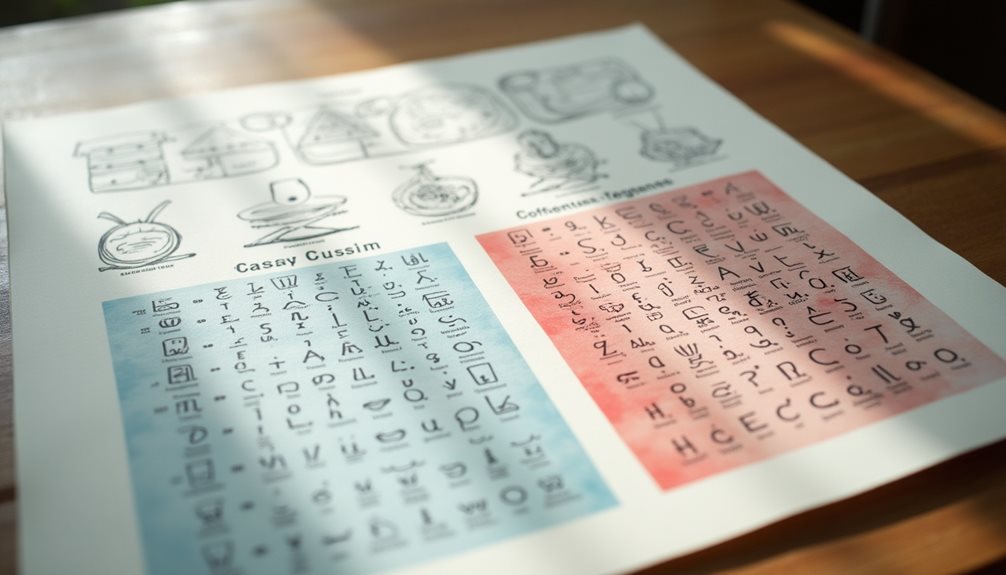Understanding the nuances of soft and hard consonants is essential for mastering Russian pronunciation. Mispronunciations can lead to misunderstandings and hinder effective communication. The distinction between these sounds often poses challenges for learners. Common mistakes, such as incorrect stress and vowel reduction, further complicate the learning process. Addressing these issues systematically can greatly improve pronunciation. The following sections will outline practical strategies and exercises that can enhance one’s skills in this area.
Table of Contents
ToggleUnderstanding Soft and Hard Consonants

In the study of Russian pronunciation, the distinction between soft and hard consonants plays a crucial role in both phonetics and meaning.
Soft consonants, characterized by a palatalization effect, result in a pronounced y-like quality. This feature alters the articulation, creating a smoother sound, as seen in examples like “л” (l’) and “н” (n’).
In contrast, hard consonants, such as “к” (k) and “т” (t), are produced without this palatal influence, resulting in a more guttural sound.
Understanding these characteristics is essential for accurate pronunciation, as the meaning of words often hinges on this distinction.
For instance, “бить” (to beat) versus “бить” (to bite) showcases the significant nature of mastering soft and hard consonants in Russian language acquisition.
When learning Russian, one of the unique challenges for English speakers is mastering the difference between soft (palatalized) and hard consonants. Unlike in English, this distinction often changes not just the sound but also the meaning of Russian words. Let’s explore this topic in more detail.
What Are Hard and Soft Consonants?
- Hard Consonants: These are pronounced without palatalization (no “y” sound). The tongue does not rise toward the roof of the mouth.
- Examples: к [k], т [t], п [p], б [b]
- Soft Consonants: These are pronounced with palatalization, which means the middle of the tongue is raised toward the hard palate, giving a slight “y” sound.
- Examples: кь [k’], ть [t’], пь [p’], бь [b’]
This difference is marked in writing: a soft sign (ь) after a consonant signals that it is soft. Vowels like е, ё, и, ю, я also signal softness when they follow a consonant.
Why Is This Important?
In Russian, the difference between a hard and a soft consonant can completely change the meaning of a word. For example:
- мать (mat’) — mother
- мат (mat) — swear word, mat (as in gym mat)
- лук (luk) — onion or bow (weapon)
- люк (lyuk) — hatch
Common Patterns
1. Letters That Can Be Hard or Soft
Most Russian consonants have both hard and soft versions. The softness is usually signaled by one of these vowels: е, ё, и, ю, я or by a soft sign (ь).
Example Table
| Cyrillic | Phonetic (Hard) | Phonetic (Soft) | English Meaning |
|---|---|---|---|
| л | l | l’ | L |
| н | n | n’ | N |
| т | t | t’ | T |
| д | d | d’ | D |
| с | s | s’ | S |
2. Consonants That Are Always Hard
Some consonants are always hard: ж, ш, ц
- ж (zh), ш (sh), ц (ts)
3. Consonants That Are Always Soft
Some are always soft: ч, щ, й
- ч (ch), щ (shch), й (y)
Examples in Words
| Word | Phonetic | Meaning |
|---|---|---|
| был | byl | was |
| бель | bel’ | linen |
| мал | mal | small (masc.) |
| мял | myal | he crumpled |
Practice: Spotting Softness
When you see these vowels after a consonant, it’s likely soft:
- е (ye), ё (yo), и (ee), ю (yu), я (ya)
If you see a ь after a consonant, it’s soft too.
Related Russian Terms
| Cyrillic | Phonetic | English Definition |
|---|---|---|
| мягкий | myagkiy | soft |
| твёрдый | tvyordiy | hard |
| мягкий знак | myagkiy znak | soft sign (ь) |
| согласный | soglasny | consonant |
| гласный | glasny | vowel |
| звук | zvuk | sound |
| произношение | proiznoshenie | pronunciation |
The Importance of Pronunciation in Russian
Pronunciation holds significant weight in the Russian language, influencing not only the clarity of communication but also the meaning conveyed. The importance of clarity in pronunciation cannot be overstated, as even slight deviations can lead to misunderstandings.
For instance, the distinction between soft and hard consonants can alter the intended message, impacting interpersonal interactions. In addition, accurate pronunciation reflects an understanding of cultural nuances, allowing speakers to engage more authentically with native Russians.
Pronunciation is a fundamental part of learning Russian, especially for English speakers. Russian uses sounds that do not exist in English, and even small mistakes in pronunciation can change the meaning of words or make speech difficult to understand. Focusing on this area from the beginning will help learners avoid confusion and communicate more confidently.
- Meaning Changes: In Russian, the difference between similar sounds—like soft and hard consonants—can completely change a word’s meaning. For example:
- брат (brat) means “brother”
- брать (brat’) means “to take”
- Clarity: Russians may struggle to understand what you mean if your pronunciation is off, especially with word stress or vowel reduction.
- Cultural Respect: Making the effort to pronounce words correctly shows respect for the language and its speakers, helping to build trust and rapport.
- Listening Skills: Improving pronunciation also sharpens your ability to distinguish similar sounds when listening to Russian.
Key Aspects of Russian Pronunciation
1. Soft and Hard Consonants
Russian consonants have both “soft” (palatalized) and “hard” versions. The presence of the soft sign (ь) or certain vowels after a consonant can change its sound:
- мать (mat’) — “mother” (soft ‘t’)
- мат (mat) — “swear word” or “mat” (hard ‘t’)
2. Word Stress
Russian words have variable stress—that is, the stressed syllable can change the meaning:
- замо́к (za-MOK) — “castle”
- за́мок (ZA-mok) — “lock”
3. Vowel Reduction
Unstressed vowels in Russian are pronounced less distinctly than in English. For example, the letter “o” is pronounced like “a” when not stressed:
- молоко́ (mo-lo-KO) — “milk”; the first two “o”s sound like “a”.
4. Voicing and Devoicing
Russian consonants at the end of words often become voiceless:
- город (GO-rat) — “city”; final “d” sounds like “t”.
Common Russian Pronunciation Challenges for English Speakers
| Russian Letter | Cyrillic | Phonetic | Example Word(s) | English Meaning |
|---|---|---|---|---|
| Ы | ы | i (as in ill, but deeper) | мы (my) | we |
| Щ | щ | shch | щука (shchuka) | pike (fish) |
| Ж | ж | zh | жизнь (zhizn’) | life |
| Х | х | kh (loch) | хлеб (khleb) | bread |
| Ю | ю | yoo | юг (yug) | south |
| Я | я | ya | я (ya) | I |
Common Pronunciation Features
| Feature | Description | Example |
|---|---|---|
| Hard vs Soft Consonants | Palatalization changes meaning | брат / брать |
| Word Stress | Stress can shift word meaning | за́мок / замо́к |
| Vowel Reduction | Unstressed vowels change sound | молоко́ |
| Voicing/Devoicing | Final voiced consonants become voiceless | город |
Understanding and practicing correct pronunciation is essential for anyone serious about learning Russian. It not only helps in being understood but also in understanding others, building relationships, and appreciating the nuances of the language and culture.
Key Differences Between Soft and Hard Sounds
While exploring the intricacies of the Russian language, learners encounter a fundamental distinction between soft and hard sounds, which plays an essential role in pronunciation.
Hard consonants, such as “к” (k), “т” (t), and “п” (p), are pronounced with a firm, clear articulation, while soft consonants, like “л” (l’), “н” (n’), and “с” (s’), are characterized by a slight palatalization, creating a softer sound.
This palatalization often occurs when consonants are followed by the vowels “е,” “ё,” “и,” “ю,” or “я.” Mispronouncing these distinctions can lead to misunderstandings, as the meaning of words can change dramatically.
Understanding these key differences is vital for effective communication and fluency in Russian.
Tips for Practicing Soft and Hard Consonants
Mastering the distinction between soft and hard consonants in Russian requires dedicated practice and a strategic approach. A highly effective method involves engaging in pronunciation drills that focus specifically on these consonant types.
Practitioners should utilize minimal pairs—words that differ only in the softness or hardness of a consonant—to sharpen their discriminative listening and speaking skills. For example, contrasting pairs like “б” (hard) and “бь” (soft) can highlight subtle nuances.
Repeatedly articulating these pairs helps reinforce correct pronunciation. Recording oneself during practice can also provide valuable feedback, allowing learners to identify areas needing improvement.
Mastering the difference between soft and hard consonants is essential for clear and accurate Russian pronunciation. English speakers often find this challenging because English doesn’t have a direct equivalent for Russian “soft” (palatalized) consonants. Below are expanded strategies and resources to help you practice and master this important distinction.
In Russian, most consonants come in pairs: one hard and one soft. The softness is indicated by a slight “y” sound, created by raising the middle of your tongue towards the roof of your mouth, much like the “ni” in “onion.” Soft consonants are often marked in writing by the soft sign (ь) or by being followed by certain vowels (е, ё, и, ю, я).
Examples of Hard and Soft Consonant Pairs
- б (b) vs. бь (b’)
- д (d) vs. дь (d’)
- л (l) vs. ль (l’)
- н (n) vs. нь (n’)
- т (t) vs. ть (t’)
Practice Strategies
1. Minimal Pair Drills
Practice with word pairs where the only difference is the hardness or softness of a consonant. Repeat them slowly, then at natural speed.
Examples:
- бал [bal] (“ball”) vs. бял [bʲal] (not a real word, but helpful for practice)
- лук [look] (“onion”) vs. люк [lyook] (“hatch”)
Try these out loud:
- мак [mak] (“poppy”) vs. мяк [myak] (“softened,” rarely used but illustrative)
- кот [kot] (“cat”) vs. кить [kit’] (“to pluck,” not common but useful for contrast)
2. Use Recording and Playback
Record yourself reading lists of minimal pairs and listen carefully to your pronunciation. Compare it to native speakers when possible.
3. Listen to Native Speakers
Watch Russian videos or listen to audio focusing on words with both hard and soft consonants. Repeat after the speaker, paying attention to the tongue position.
4. Practice with Tongue Position
Pay close attention to where your tongue is when you pronounce soft consonants. You should feel the middle of your tongue rise toward the roof of your mouth—almost as if preparing to say an English “y.”
Additional Practice Words
Try practicing with these real Russian words to get a feel for both soft and hard consonants:
| Hard Consonant | Soft Consonant |
|---|---|
| брат [brat] | брать [brat’] (“to take”) |
| мел [myel] (“chalk”) | мёль [myol’] (“mole,” type of animal) |
| лук [look] | люк [lyook] |
Common Mistakes in Russian Pronunciation
Many learners encounter specific pitfalls when attempting to pronounce Russian sounds, which can impede effective communication. Common errors often stem from confusion between hard and soft consonants, leading to phonetic pitfalls that alter meaning.
| Common Errors | Examples | Correct Pronunciation |
|---|---|---|
| Hard/Soft Confusion | б (b) vs. бь (b’) | батон (baton) vs. бьет (byet) |
| Stress Misplacement | молоко (moloko) | молоко (moh-lah-KOH) |
| Vowel Reduction | мама (mama) | мама (MAH-ma) |
| Intonation Issues | вопрос (vopros) | вопрос (vuh-PROHS) |
Awareness of these common phonetic pitfalls can greatly enhance pronunciation accuracy, fostering clearer communication in Russian.
Exercises to Improve Your Pronunciation Skills

Improving pronunciation skills in Russian requires targeted practice and specific exercises that focus on the unique sounds of the language. Engaging in pronunciation drills can markedly enhance a learner’s ability to articulate soft and hard consonants correctly.
These drills often involve repeating pairs of words that illustrate sound differentiation, such as “т” (t) versus “ть” (ty). Additionally, utilizing minimal pairs—words that differ by only one sound—can aid in honing awareness of subtle phonetic distinctions. Practice saying the words “мать” (mat’, meaning “mother”) and “мат” (mat, meaning “swear word”) to hear the difference between soft “ть” ([tʲ]) and hard “т” ([t]).
Recording oneself while practicing can provide valuable feedback for self-correction. Regularly incorporating these exercises into a study routine fosters not only confidence but also a deeper understanding of Russian phonetics, allowing for clearer communication and greater fluency.
Listening to Native Speakers for Better Pronunciation
Listening to native speakers serves as a powerful method for learners to refine their Russian pronunciation. By employing effective listening techniques, individuals can better grasp the nuances of native accents, which greatly influence pronunciation accuracy. Engaging with authentic audio materials, such as podcasts or films, allows learners to hear the rhythm and intonation patterns characteristic of the language.
| Listening Techniques | Benefits |
|---|---|
| Shadowing | Improves fluency and rhythm |
| Dictation | Enhances auditory discrimination |
| Repetition | Reinforces correct pronunciation |
Through consistent practice with native speakers, learners can develop a deeper understanding of soft and hard consonants, ultimately leading to more authentic communication in Russian.
Frequently Asked Questions
How Do Soft Consonants Affect Word Meaning in Russian?
Soft consonants in Russian, such as “л” (l) and “н” (n), can alter word meanings compared to their hard counterparts like “л” (l) and “н” (n). This distinction is vital for accurate communication and comprehension.
Are There Regional Variations in Soft and Hard Consonant Pronunciation?
Regional variations in soft and hard consonant pronunciation are evident, particularly between Moscow dialects and Siberian accents. These differences can influence both clarity and meaning, showcasing the rich diversity of the Russian language across regions.
What Are Some Examples of Minimal Pairs in Russian Pronunciation?
The concept of minimal pairs in Russian pronunciation practice highlights distinctions such as “бит” (beat) versus “бить” (to beat) and “мир” (peace) versus “мир” (world), illustrating subtle phonetic contrasts essential for mastering the language effectively.
How Can I Identify Soft vs. Hard Consonants in Writing?
Identifying consonants in writing requires understanding specific markers, such as the presence of softening signs or adjacent vowels. Effective writing techniques emphasize recognizing these cues to distinguish between soft and hard consonants accurately and confidently.
Is There a Specific Accent That Affects Soft and Hard Consonants?
The question of accent influence reveals that dialect variations in Russian can considerably impact the pronunciation of soft and hard consonants, leading to distinct regional characteristics that learners must navigate to achieve clarity in communication.



